by SERGEY KADINSKY
Forgotten NY correspondent
Across the street from the world-famous Central Park there is an older park that hosts the American Museum of Natural History. With a controversial museum expansion underway, most people do not realize that the green space around the museum is a public park predating Central Park by nearly a half century.
Theodore Roosevelt Park carries the name of the Manhattan-born 26th President, who previously served as Vice President, Governor, Police Commissioner, and Assemblyman. A naturalist who traveled the world in search of exotic species, his name and monument are an ideal fit in front of the natural history museum.
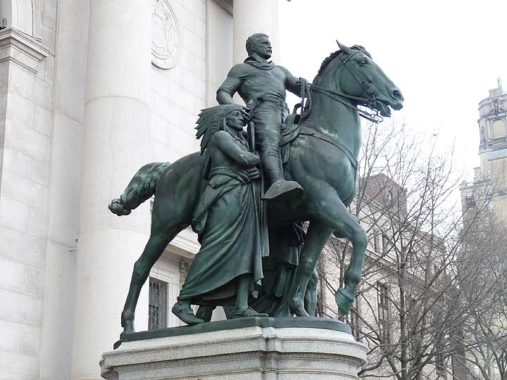
In recent years the depiction of Roosevelt on horseback accompanied by a Native American and an African has been facing protest from “woke” activists charging that the depiction is racist. As with most historical figures, Roosevelt’s views on race are complicated and should be kept in the context of his time. Designed by James Earle Fraser, the sculpture was unveiled in 1940. Actor Robin Williams portrayed Roosevelt’s statue coming to life in the 2006 film Night at the Museum.

The statue isn’t the only tribute to the Bull Moose candidate. The classicist entrance hall behind the monument is covered with murals relating to events during his presidency. One detail of his administration is the Portsmouth Treaty of 1905 that ended the Russo-Japanese War. There’s also a statue of TR sitting on a bench in the shadow of the t-rex skeleton.

The park’s story begins in 1807, when the Commissioners Plan allocated a sprinkling of public squares across Manhattan. Tompkins Square Park and Madison Square Park have their origins in this plan, as are the unbuilt Hamilton Square on the Upper East Side, Observatory Place in Yorkville, and Harlem Square. This park initially had the unimaginative name Manhattan Square. As late as 1870, it was undeveloped and still had a piece of Saw Kill flowing through it. Prior to the development of Central Park, this stream flowed across the landscape towards the East River. Portions of it are preserved as The Lake, Conservatory Water, and the now-buried Ladies Pond.


The Natural History Museum arrived in the park in 1874, and as its master plan slideshow illustrates, the museum continued to grow in size for the next century and beyond.

The 1879 Bromley map shows a proposed set of paths in the park that preserves the stream as a pond, accommodates the museum, and has an arch spanning across Central Park West, connecting to the larger park. This plan provided an Olmstedian look to Manhattan Square, matching it with Central Park.
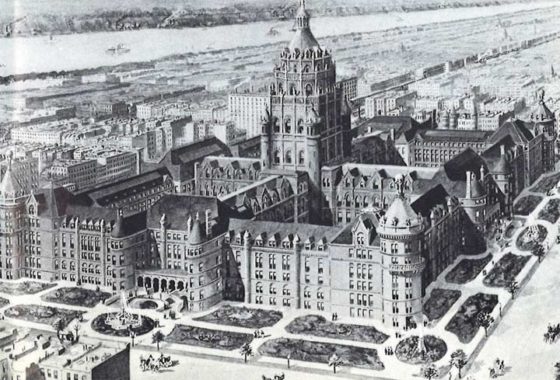

The greatest expression of the museum’s design was its 1897 master plan that envisioned a symmetry of four identical quadrants with a tower at the center. Only the sides facing W. 77th Street and Central Park West received the appearance of this plan. Subsequent expansions came in piecemeal fashion in the appearance of their contemporary styles.
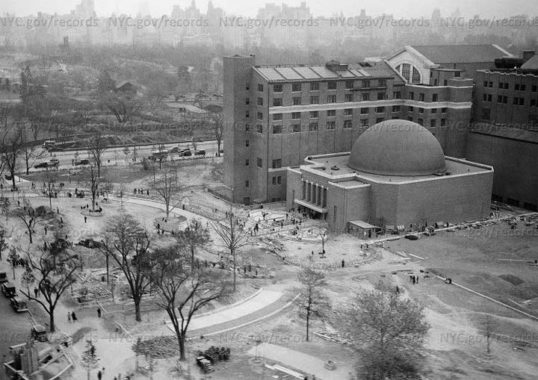
In 1935 the Hayden Planetarium was added to the museum in an Art Deco style similar to that of the 1939 World’s Fair, Chicago’s Adler Planetarium, and Los Angeles’ Griffith Observatory. This planetarium was replaced in 2000 by the much larger postmodern-style Rose Center for Earth and Space.
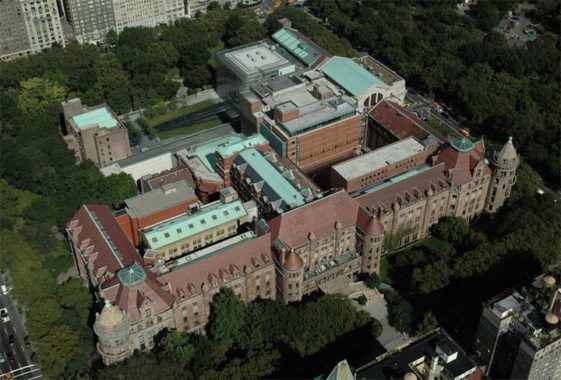
As with the Metropolitan Museum on the opposite side of Central Park, a view from above shows the piecemeal nature of its expansion and the incomplete 1897 vision of the facility. Behind the exhibits are numerous restricted spaces used for offices, storage, and research.
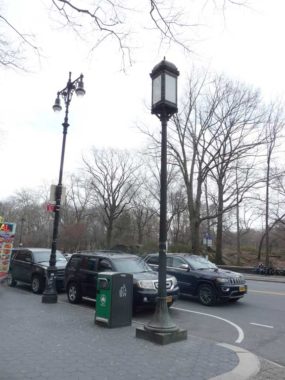
On the Central Park side of the museum are four unique lampposts plus two smaller ones flanking a subway entrance that have a beaux arts design. Kevin Walsh documented them in his 1998 photo essay on ancient subway signs.
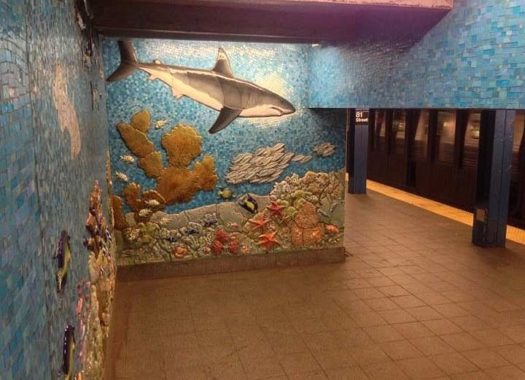
The station below is named after the museum and provides access into the museum’s basement so one does not need to go outside. The only other station I know where one can directly access its namesake is the Hunter College station on the 6 train. The 81st Street- American Museum of Natural History station features the 2000 installation For Want of a Nail, which notes how everything is connected in nature. The station opened in 1932 ahead of the closing of the Ninth Avenue El a block to the west on Columbus Avenue. In 2018, two other stations on the Central Park West line, 72nd Street and 86th Street, received their own public artworks to enliven the boring IND bathroom tile walls.

Throughout the city one can find monuments donated by foreign governments, befitting New York’s role as the “world’s capital.” Theodore Roosevelt Park has a monument to Alfred Nobel, sponsored by Sweden. It honors the founder of the world’s most prestigious prize and all of its American laureates. There is also the New York Times-sponsored time capsule in the park designed by starchitect Santiago Calatrava, scheduled for reopening in the year 3000. Not quite as long a wait as the World’s Fair capsules that will be unearthed in 6939 and 6934. Untapped Cities has a photo essay on other time capsules found across the city.
Much of the material for this essay can be found in the Oct. 2016 article on the New York YIMBY blog that features renderings of the museum’s past and its plans for the future with its Gilder Center. And with all the growth, the history of its host park is not forgotten. Be sure to explore the surrounding neighborhood with Daytonian in Manhattan, who wrote about 44 West 77th Street, the Manhattan Square Apartments that preserves the park’s original name. There’s also the Humboldt Monument on Central Park West. Finally, for more city history, across from the museum is the New-York Historical Society, where one can learn why they hyphenate the name.
Sergey Kadinsky is the author of Hidden Waters of New York City: A History and Guide to 101 Forgotten Lakes, Ponds, Creeks, and Streams in the Five Boroughs (2016, Countryman Press) and the webmaster of Hidden Waters Blog.
Check out the ForgottenBook, take a look at the gift shop, and as always, “comment…as you see fit.”
2/8/19


4 comments
While Theodore Roosevelt was famed much of his life for his physical vitality and activity, he died a doddering old man at the age of only 60. What did him in so soon were the effects of his ill-fated 1913/1914 exploration of the Amazon tributary called the River of Doubt. Roosevelt was the co-leader of the expedition along with the Brazilian military officer Candido Rondon, famed for his Amazon explorations and his campaign to protect the indigenous inhabitants. It was an extremely grueling trip, and Roosevelt came down with what probably was malaria and was left near death. His 24-year-old son Kermit, who was accompanying him, had to care for his helpless father and ignored his pleas to be left behind to die so as not to jeopardize the rest of the explorers.
Roosevelt was never the same again. He spent the following years plagued by repeated infections of the leg he had injured during the trip as well as general physical decline. When he died age 60, he was physically equivalent to a man at least two decades older.
He actually wasn’t the only victim of the brutal trip. Although Kermit Roosevelt survived the journey physically intact, he soon thereafter began a lifelong struggle with alcohol and depression that defied all treatment, and at age 53 he shot himself. Candido Rondon was much luckier, however; he eventually became the commander of the Brazilian armed forces, lived into his 90’s, and had a state named after him.
In all honesty, I never knew that was an actual park and I usually just think it’s a little seating area outside of the AMNH.
Great article, Always thought the same as Tal ^- Until recently when it came up that they want to expand. Also, I believe Lincoln Center has direct access to the 1 train.
Ha! Now I’m gonna go to Lincoln Center and take a look.